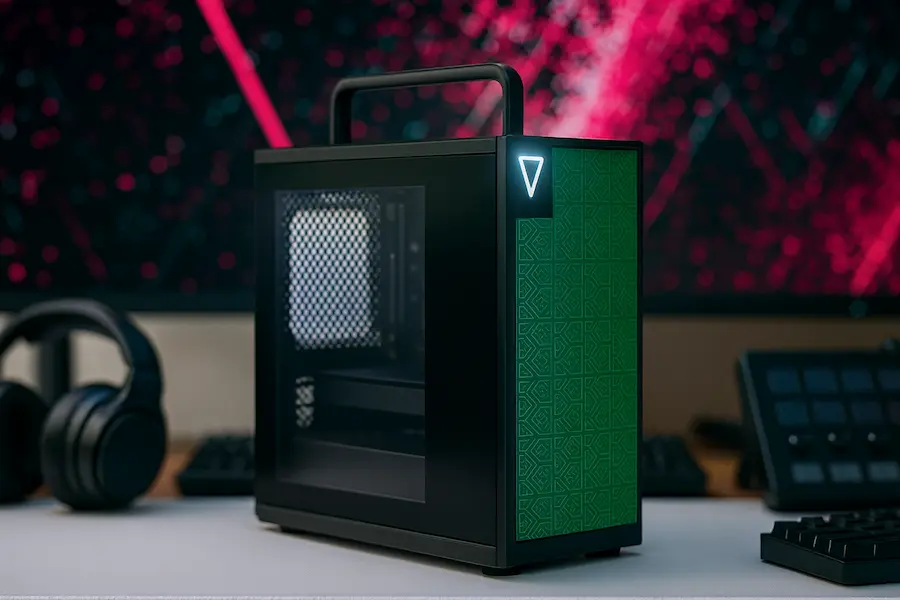TL;DR
Framework brings its famous repairable-laptop philosophy to the desktop world. The Framework Desktop 2025 is a compact, quiet, and powerful workstation tuned for AI developers, video editors, 3D artists, and creators who value modularity and sustainability. The big caveat: the APU and RAM are soldered, so you choose your performance tier at purchase. If you want a small yet serious machine you can maintain and customize for years, this is a standout choice.
Target Keywords: modular desktop for AI, best workstation for developers, high-performance AI workstation
Why a Framework Desktop Exists (and Why It Matters)
Desktops have always been “customizable,” but true modularity and repairability are rarer than they should be. Framework’s founder Nirav Patel set out to bring the brand’s upgrade-first mindset from laptops to a small-form-factor desktop that professionals could actually live with: quiet, compact, and easy to service.
At the heart of the Framework Desktop 2025 is AMD’s Ryzen AI Max APU, which blends CPU, GPU, and NPU to accelerate the kinds of tasks developers and creators rely on local model inferencing and finetuning, timeline scrubbing, encodes, renders, and batch operations. With configurations up to 128GB of RAM and excellent memory bandwidth, it targets serious workflows without turning your workspace into a wind tunnel.
Modularity: Flexible Where It Counts, Fixed Where It Hurts
Framework’s laptops are famously modular. The Framework Desktop 2025 mostly follows suit storage, Wi-Fi, and expansion/I/O are user-swappable yet there’s a notable limit: the APU and RAM are soldered to the motherboard. That means you pick your performance tier upfront. If you outgrow it later, the upgrade path is a motherboard swap (Framework prices these typically in the $799–$1,699 range), which is still more sustainable than tossing the entire system but not as cheap as dropping in new DIMMs or a socketed CPU.
Available configurations:
- Ryzen AI Max 385 • 32GB RAM • Radeon 8050S GPU
- Ryzen AI Max+ 395 • 64GB RAM • Radeon 8060S GPU (the model I tested)
- Ryzen AI Max+ 395 • 128GB RAM • Radeon 8060S GPU
Target Keywords: modular desktop PC, AI workstation with upgradable parts, modular desktops for video editing
Design & Build: Compact, Clean, and Surprisingly Personal
Framework Desktop 2025 opted for a 4.5L Mini-ITX enclosure small enough to disappear beside a monitor arm but big enough for proper airflow. The aesthetic is understated from afar, but the 21 removable front tiles bring personality. Swap colors (black, green, orange, lavender), pick partner designs (Framework, AMD, Linux), or 3D-print your own for branding or team identity. It’s a rare, fun way to make a workstation feel yours.
Ports & Connectivity (base panel):
- 2× USB-C
- 2× USB-A
- 2× DisplayPort
- HDMI
- Gigabit Ethernet
- 3.5mm audio combo
The real trick is the expandable I/O concept. If your workflow leans on more display outputs, extra USB-C, or specialized interfaces, you can add or rearrange modules rather than replacing the whole machine.
Target Keywords: compact customizable desktop PC, modular PC design, high-performance compact desktop
Setup & Installation: Truly 15 Minutes
Framework’s documentation is clear and step-by-step. Unlike a full DIY build, most of the heavy lifting arrives done. You’ll typically:
- Mount your SSD
- Install the 120mm fan
- Seat the heatsink
That’s it. The process took about 15 minutes. Install your OS of choice and you’re working the same afternoon. For anyone who’s built a tower on a deadline, that friction-free start is a delight.
Target Keywords: easy desktop setup, quick desktop assembly, Framework Desktop installation guide
Performance: Tuned for AI, Editing, and 3D
This machine isn’t pitched at casual users or hobbyist gaming first it’s very clearly a workstation. With the Ryzen AI Max APU, you get a balanced profile for multithreaded CPU loads, GPU-assisted rendering, and NPU-accelerated ML tasks without needing a monster case.
AI/ML Workloads
In practical use, the Ryzen AI Max platform shines when moving between data prep, model training, and inferencing on mid-to-large local models. During my testing, Google’s Gemma 3 27B ran smoothly with no thermal drama or system instability. That NPU integration reduces pressure on the CPU/GPU for certain AI operations and helps keep system responsiveness high while tasks run.
Video Editing
For editors, the Desktop 2025 feels instantly “ready.” Timeline scrubbing in high-bitrate projects is smooth, and exports are quick. In one test, a 39GB project rendered in 1 hour 12 minutes, a notable edge over typical mainstream desktops in the same size class. You can stack LUTs, effects, and multicam edits without trudging through a laggy experience.
3D Rendering
For 3D artists who bounce between Blender, Maya, Substance, and batch baking tools, the system puts up consistent render times. It’s not a 600W triple-slot GPU monster, but that’s the point you’re getting professional throughput in a chassis that’s friendly to your ears and your space.
Gaming (Secondary, Not Primary)
The Radeon 8060S handles modern titles well Fortnite at ultra settings and Hardspace: Shipbreaker at max were smooth in testing but if your day ends with 240Hz competitive shooters or path-traced epics, a dedicated gaming tower will still do better.
Target Keywords: best desktop for AI development, high-performance desktop for 3D rendering, modular desktops for video editing
Acoustics & Thermals: Quiet Confidence
A single quality 120mm fan paired with sensible airflow makes a difference. Even when hammering the system with encodes and ML tasks, fan noise remained remarkably quiet the sort of machine you can run in a shared office, editing suite, voiceover booth, or late-night coding session without creating a distraction. Sustained loads don’t trigger the kind of thermal spikes that force sudden, jarring fan ramps.
Target Keywords: quiet desktop for AI, efficient desktop cooling, silent workstation PC
Pricing & Configurations
Framework positions the Desktop 2025 where it makes sense for professionals: pay for throughput, reliability, and serviceability skip the bulk and RGB.
Price overview:
- Base (32GB): $1,099
- Mid-Tier (64GB): $1,599
- High-End (128GB): $2,286
Note that essentials like SSD, CPU fan, and OS may be selected separately, so factor those into your total. Even fully configured, the premium buys you serviceable longevity and a smaller footprint than typical workstations.
Target Keywords: Framework Desktop pricing, modular desktop pricing comparison, value for money AI workstation
Framework Desktop 2025 vs. Competitors
You’ll naturally compare Framework with mainstream towers like Lenovo Legion Tower 5 and ASUS ROG desktops. Those are excellent generalists and often skew more gaming-forward. Framework’s stance is different: creator-centric, repairable, and compact, with a modular I/O philosophy.
| Feature | Framework Desktop 2025 | Lenovo Legion Tower 5 | ASUS ROG (Strix/ROG variants) |
|---|---|---|---|
| Form factor | 4.5L Mini-ITX | Mid-tower | Mid-tower |
| Modularity | High (I/O, storage, modules) | Low-Medium | Low-Medium |
| Core upgrades | Board swap for APU/RAM | Socketed CPU/RAM in many SKUs | Socketed CPU/RAM in many SKUs |
| Creator focus | Strong (AI/Video/3D) | Mixed (often gaming-first) | Gaming-first |
| Acoustics | Quiet under load | Varies by SKU | Varies by SKU |
| Sustainability | Brand priority | Typical OEM | Typical OEM |
If you live in Resolve, Premiere, Blender, Python notebooks, and local LLM tooling, Framework’s balance is compelling. If you want the absolute highest FPS, a bigger gaming tower with a higher-wattage GPU will win but at the cost of noise, size, and sometimes upgrade friction.
Buyer’s Guide: Is It Right for You?
Buy the Framework Desktop 2025 if you:
- Build, finetune, or run local AI models and want NPU-assisted workflows.
- Spend your day in DaVinci Resolve, Premiere Pro, After Effects, Blender, Maya, or similar pro apps.
- Need a quiet, compact workstation that won’t dominate your desk (or your audio recordings).
- Care about repairability, modular I/O, and sustainability.
- Prefer a system you can service yourself without vendor lock-in.
Consider alternatives if you:
- Primarily game and want maximum frames-per-second and GPU headroom.
- Upgrade CPU/RAM every year and don’t want to swap motherboards.
- Want the cheapest path to raw performance regardless of size, efficiency, or acoustics.
Pros & Cons
Pros
- Compact 4.5L chassis with serious workstation chops
- Modular I/O and user-serviceable storage/Wi-Fi
- Quiet even under sustained CPU/GPU/NPU workloads
- Excellent for AI, editing, and 3D pipelines
- Sustainability and long-term repair ethos
Cons
- APU & RAM are soldered (core upgrades require a motherboard swap)
- High-end config can be pricey once fully built out
- Not optimized for hardcore gaming-first buyers
Workflow Notes & Real-World Use
For AI Developers
You can keep your data local, iterate quickly on tokenizers/embeddings, run inference servers for prototypes, and still have a responsive Framework Desktop 2025 for notebooks and dashboards. The NPU helps offload the kinds of operations that tie up traditional CPU/GPU pipelines, smoothing multitasking while training runs.
For Video Editors
The export time on that 39GB project tells a story: real speed, real throughput, real stability. You’ll also appreciate the low noise floor when monitoring audio, plus the small footprint if your suite or desk is already packed with drives and panels.
For 3D Artists
It’s a capable daily driver for viewport work, material baking, test renders, and batch output especially if you value working in a quiet space. For final frames that demand top-end GPUs, you can still farm those out to a render node or cloud pipeline while the Framework desktop handles your scene iteration.
Upgradability, Service, and Longevity
While APU/RAM are fixed, Framework leans into long-term serviceability everywhere else. Storage is easy to expand, I/O modules can be swapped as standards evolve, and motherboard replacement offers a path to future CPU/NPU generations without scrapping the whole system. This is a smarter, more sustainable take on “upgradeability” than many disposable desktops.
Sustainability & Aesthetics
Framework Desktop 2025 ethos matters. The front-tile system isn’t just flair; it’s a subtle reminder that your tools can reflect your identity while staying practical and repairable. If you care about e-waste reduction and the ability to fix what you own, this desktop aligns with that mindset better than most.
Pricing & Value: Who Gets the Most for the Money?
If your workload is developer- or creator-centric, you’ll feel the value daily in quiet performance, desk space reclaimed, and the security of a machine you can open and service without fear. If you mostly browse, email, and game, you’ll get better bang-for-buck from mainstream towers but that’s not the buyer this machine is built for.
FAQs About the Framework Desktop 2025
Is the Framework Desktop 2025 good for gaming?
It can play modern titles smoothly (e.g., Fortnite, Hardspace: Shipbreaker at high settings), but it’s designed first for AI, editing, and 3D workloads. If gaming is your top priority, a larger gaming tower with a higher-wattage GPU will score more frames.
Can I upgrade components?
Yes and no. APU and RAM are soldered; upgrading them later requires a motherboard swap. You can freely upgrade SSD, Wi-Fi, and expansion/I/O modules.
How easy is setup Framework Desktop 2025?
Very. Expect about 15 minutes to install the SSD, fan, and heatsink, then add your OS. Framework’s guides make it straightforward even for first-timers.
What are the prices Framework Desktop 2025?
$1,099 (32GB), $1,599 (64GB), and $2,286 (128GB), with storage/fan/OS selections added as needed.
Who should buy it Framework Desktop 2025?
AI developers, video editors, 3D artists, and creatives who value a quiet, compact, repairable workstation for serious daily work.
Does it support multiple monitors?
Yes. With dual DisplayPort plus HDMI (and modular I/O), multi-display setups are easy to configure.
What operating systems can I use?
It’s designed to be flexible. Choose the OS that best fits your workflow and software stack.
READ ALSO:Tesla Dojo Shutdown: Bold Strategic Pivot to Next-Gen AI5 & AI6 Chips

